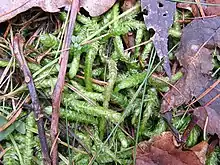| Plagiotheciaceae | |
|---|---|
 | |
| Plagiothecium undulatum | |
| Scientific classification | |
| Kingdom: | Plantae |
| Division: | Bryophyta |
| Class: | Bryopsida |
| Subclass: | Bryidae |
| Order: | Hypnales |
| Family: | Plagiotheciaceae Fleischer and Broth. |
| Genera | |
|
See text | |
Plagiotheciaceae is a family of mosses from the order Hypnales. It is found almost nearly worldwide,[1] including Antarctica. Located primarily in temperate latitudes and at higher elevations in the tropics.[2]
Named after Plagiothecium, which has over 150 species.
It originally had 2 subfamilies, Plagiothecioideae (which contained Catagonium and Plagiothecium), and Stereophylloideae (which contained Entodontopsis, Pilosium, Stenocarpidopsis, Stenocarpidium and Sterephyllum).[3]
Genera
As accepted by GBIF;[1]
- Acrocladiopsis (V.F.Brotherus) J.Cardot, 1914
- Bardunovia Ignatov & Ochyra
- Complanato-Hypnum Hampe, 1878
- Isocladiella Dixon
- Isopterygiella Ignatov & Ignatova, 2020
- Isopterygiopsis Z.Iwats.
- Ortholimnobium Dixon
- Pilaisaea
- Plagiotheciella M.Fleisch. ex Broth.
- Plagiothecium Bruch & Schimp.
- Pseudotaxiphyllum Z.Iwats.
- Saviczia A.L.Abramova & J.J.Abramov, 1966
- Sharpiella Z.Iwats.
References
- 1 2 "Plagiotheciaceae". gbif.org. Moss TROPICOS Database. Retrieved 29 June 2022.
- ↑ "Plagiotheciaceae - FNA". beta.floranorthamerica.org. Retrieved 29 June 2022.
- ↑ Pedersen, Niklas; Hedenäs, Lars (Autumn 2002). "Phylogeny of the Plagiotheciaceae Based on Molecular and Morphological Evidence". The Bryologist. 105 (3): 310–324.
Other sources
- Buck, W. R. and R. R. Ireland. 1985. A reclassification of the Plagiotheciaceae. Nova Hedwigia 41: 89–125.
This article is issued from Wikipedia. The text is licensed under Creative Commons - Attribution - Sharealike. Additional terms may apply for the media files.